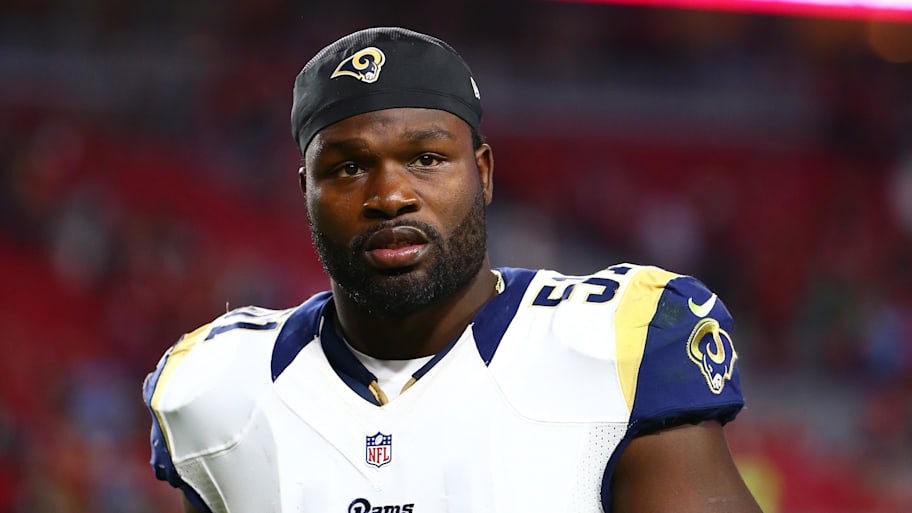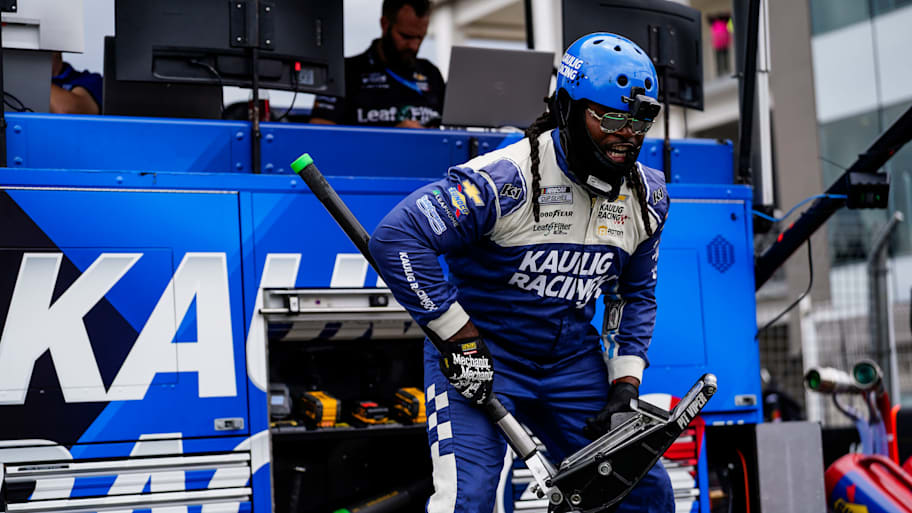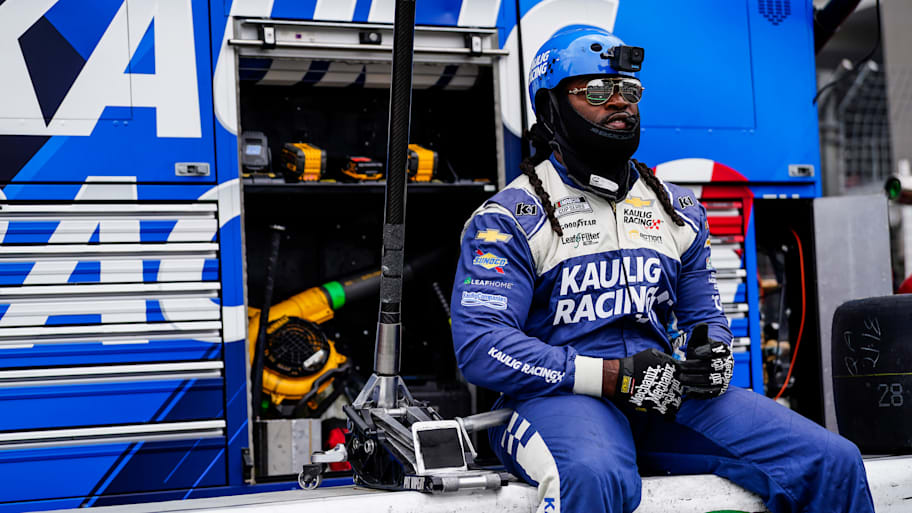Despite growing up just a short drive from Darlington Raceway, Marshall McFadden never had much interest in cars or auto racing. Like every kid in Lamar, S.C., he was obsessed with football. Despite having a population of less than 1,000, the town has produced a handful of NFL players, including former defensive end John Abraham, who was a three-time first-team All-Pro during his 15-year career. McFadden played other sports, but, understandably, football was his focus.
He was a good enough linebacker to catch on as a special teams ace with three NFL teams in as many years. But after spending a season in the CFL, McFadden hung up his cleats for good in 2017. And then things got interesting.
On the recommendation of a friend, he started volunteering at Chip Ganassi Racing, which is headquartered near his home in Charlotte. That led to a job as a member of a pit crew. Now, McFadden is the jackman on driver A.J. Allmendinger’s crew in the NASCAR Cup series. And he’s become a fixture in Cup racing faster than a Next Gen car can go from 0 to 60. More importantly, he says he’s now living his best life.
McFadden is hardly alone. With pit stops getting faster and more physically demanding, there has been a rush among teams to sign former college athletes to carry tires and haul fuel cans. In fact, McFadden isn’t the only NFL or college football veteran jumping over the wall on pit road. Others include Josh Bush, a former defensive back who won a Super Bowl with the Broncos and Jeremy Kimbrough, a former linebacker at Appalachian State.
SI sat down with McFadden recently to ask him about his journey from the gridiron to the pit box, to find out how someone makes the jump from the NFL to NASCAR and more.
SI: What was your Welcome to Racing moment?
Marshall McFadden: To be honest with you, man, my first race. I didn’t know much about racing. A friend had invited me to practice one day, and I just kept at it, kept at it, kept at it, kept at it. And I finally signed a contract; really didn’t know what I was getting myself into, though. And, you know, the first race of the season is Daytona. It’s one of the biggest races of the year. And I think for me, when I put on my fire suit and went out there, I was amazed. It gave me, you know, a football feel. I mean, the people, the crowd. Peyton Manning was there. It was great, man. The light show, the national anthem, the flyover. I was like, Wow. Like this is really big. So, it was a great introduction for me. I was in awe.
It was the 2018 Daytona 500. I was with Chip Ganassi Racing at the time, but I was pitting for StarCom Racing. I was the fuel man for Jeffrey Earnhardt.
SI: So you worked for Ganassi but pitted for StarCom? Do you bounce between drivers and crews and series?
MM: Yeah. My first, six, seven years I did Xfinity and trucks, and usually once I get assigned to a team, that’s who I’m with for the year. Like we contract pit crews. We contract some of our pit crews out to colleagues. So, like this year, I only pit for A.J. Allmendinger. I don’t do trucks and Xfinity anymore. I only do the Cup series now. So, I work at Trackhouse Racing, but I pit for A.J., even though he's not a Trackhouse team guy. We are contracted out to colleagues, even though I’m under the Trackhouse umbrella. And me and my crew are doing really well this year. It’s been fun. It’s been a fun ride.
SI:You grew up in South Carolina, just a few minutes from Darlington Raceway, but you weren’t a racing fan. What did you do instead of watching racing or going to the races?
MM: Play football. I’m from Lamar, South Carolina. I mean, the racetrack is in [Darlington] county, so we were five to 10 minutes away. But we eat, sleep and breathe football. We from a small town with one stoplight, and we breed football players. In the past decade or so, we had like five people to go to the NFL. You got a better chance of being struck by lightning than doing what we’re doing from that small city. I know three years straight—from a IA division—we won three state championships; five straight in track. So, it was football and track and basketball. I was mainly football. Football is all we do there. That’s it. It’s in the water.
SI: What was your event in track?
MM: You won't believe it. I actually pole-vaulted. [Laughs.] I triple-jumped. I long-jumped. And I did the 400 in there, too.
SI: Was playing college football your goal?
MM: I wasn’t the biggest guy. I wasn’t, man. And where I come from, coming from a poverty standpoint, I didn’t think beyond high school. I’m just being honest with you. It wasn’t a goal of mine. I was good at football, and I was O.K. But I never knew that I would get a full ride to go to college until like my senior year, after I got MVP in the North-South All-Star Game. Then the college letters just started coming in.
SI: Did you work in addition to playing football when you were in high school?
MM: Man, I worked, man. When I say I work, not only did I work, man, I worked and I worked. Everything that I got, I had to work for. And just being a country boy, you know, the stuff that I had to do was hard labor. You know what I mean? Tobacco—working in the tobacco field, doing yard work. Even when South Carolina State came to visit me, the guy who I was working for, they pulled up at this house and I was in a swamp weeding with my shirt off, weeds all over me. And I got these college coaches pulling up on me? It was the wildest thing ever.
They talked to me, they talked to the guy I was working for a little bit. And they was intrigued and, you know, wanted to give me a full scholarship, I still don’t know how they found me, though. [Laughs.] I still don’t know how, but they did.

SI: You caught on in the NFL as an undrafted free agent, but that wasn’t until 2012, a year after you had finished playing at South Carolina State.
MM: Facts. In college, man, I was injury-prone. I dislocated my wrist, was out for a season. I dislocated my elbow, was out for a season. And in my senior year I pulled my hamstring, so I only played in a handful of games. I probably played in seven games, and two of them I got hurt in. So, it wasn’t a productive senior year for me. It wasn’t productive at all. I had a subpar pro day, and it was a lockout year, as well. So, everything was expedited once the lockout was over—everything got expedited at the start of the season. And I was just one of those guys that was left out high and dry. All my NFL hopes went out the window.
I was still talking with my agent, Brian Anderson, but nothing really ever happened. And then once it got late into the season, you know, I kind of moved on with my life. I was working at Velocity Sports, and I was helping train kids there. And the good thing about training people is that you train also, so I kept myself in shape. I kept training. And that’s when the Pittsburgh Steelers lost against the Denver Broncos in the playoffs.
I’d decided to go home to Darlington, South Carolina. And me and my mom was eating dinner, and that night I got a call from Dan Rooney. It was a 312-34-something number. I was like, Man, who is this? So, luckily, I pick up the phone: “Hey, this is Dan Rooney from the Pittsburgh Steelers.” And I looked at my mom, and she looked at me like, Well, that’s a different kind of look. And Dan was like, “Hey, Marshall, how you doing? Just calling to check up on you.” He was one of the guys that had come to see me when I dislocated my wrist—he’d come to one of my practices to see me. And he said, “I think you’re a second-round draft pick.” But I was out for the season. And that kind of went by and he doubled back after I’d been out for a year—they lost against the Broncos, and the next day he called. He asked where I live. I was like, “I live in Charlotte, North Carolina.” He was like, “Well, I’m in Gastonia. When you get back, give me a call. We’ll have lunch.” I think he wanted to see what I would look like. So, I met him for lunch—and I think he had his two boys with him—and we talk and such and such.
And when I got back home by that night, I already had an email telling me to fly out to Pittsburgh that following weekend. And on that visit, I still don’t know much. I think I’m just visiting. But no, I had to work out. Not only did I have a workout, there were 12 or 13 other guys there to do the same thing. After the workout, we all went upstairs, and they was calling these guys one by and one, one by one, one by one, one by one. And all of these guys was getting walked out, obviously to catch a flight and head back home. I was the last guy there, and I didn’t know what that meant. But I left with a futures contract, and that’s how my career started.
SI: How did you get connected with Ganassi Racing after you retired in 2017?
MM: Everything ran through Velocity Sports, because I didn’t know anybody when I came up to Charlotte to be near my agent. A guy named Curtis Walls was one of the coaches at Velocity, and he’d actually played pro football as well—for the arena team in Pittsburgh. I met Curtis at Velocity and our friendship started there. And later on he got into NASCAR. And then when he found out that I was done with football he was like, “Hey, man, you should come check this out.” I was like, What? NASCAR? But I also didn’t really have anything going on, so I went to check it out. And it was amazing. You had athletes, guys with training who were was pitting cars. It was competitive. There were coaches. It was everything that I would value in my post-football career. And it just kind of went from there thanks to Curtis Walls.
SI: But it wasn’t like you went to Ganassi and got hired. You volunteered for five or six months.
MM: I even took road trips to some of the races, without even getting paid a dime—just embracing it, just wanting to get an opportunity. It isn’t just something that they give you; it’s something that you have to work for. And the coaches saw that, you know, I was willing to put my pride aside—especially coming from the NFL—and put in the dirty work. And eventually they offered me a contract and it kind of went from there.
SI: Had you ever worked on a car before? Or even changed a tire?
MM: Never. Never. That’s the beauty of it. That ain’t what I did coming up. I didn’t have a father to teach me those things or show me those things. And I worked. I cut grass. I cleaned out swamps. I worked in fields.

SI: For you, what is the appeal of working on a pit crew?
MM: I mean, all I knew was just working with a team of 11 guys all my life. The only thing I knew was to compete. And this gave me a reason to still get up in the morning and compete. And I just love being with different people from different parts of the world. It was just great. It gave me that locker-room feel again. And you have your ups and downs. I have that good stress factor, when you gotta figure something out and there’s no room for error. It was great, man. It was all worth it, for sure.
SI: Why do racing teams want former college athletes on their pit crews?
MM: Well, you see, what happened was that these stops went from 25, 20, 30 seconds way back when, down to 17 to 15 seconds. And now with the Next Gen car down to one lug nut [from five], you’ll probably see a team here shortly do it in seven seconds. So, you got to go and get top-notch athletes now. And I just think that once the teams started going to get these athletes, and you’re starting to see how fast these stops are, you know what everybody else is gonna do. So, it’s just a trend. You better have some athletes out there. If not, then, you know, ain’t too many spots you’re going to gain out there on pit road.
SI: Any advice for guys who want to do what you do?
MM: I do, man. It’s just so many kids that want to play basketball, football, soccer, baseball, whatever. But, realistically, it’s only small percentage of those people that actually get an opportunity. But for athletes out there, I think maybe you should look at the NASCAR side of things. Not only from a pit-crew standpoint, but also for an engineer, a coach. You can do this for a long time, it’s a really good living, and you still get to compete. And even more so this year, I think a light has been shined on the former athletes and what we do in our roles. And I think that it’s very attractive. So, for some of you young athletes out there, I think you should take a chance because I’m living my best life in my post-NFL career. And it’s been amazing.
SI: Special teams in the NFL are meticulously choreographed. Is a NASCAR pit crew anything like that?
MM: Even more, all the way down to the millisecond—things you probably can’t even see with the eye, if that makes any sense. Because, you think about it, we change four tires and a full tank of fuel and make adjustments in 8½ seconds—and sometimes eight flat. We just did a stop in Darlington in, I think, around 8.2 or 8.1, something like that. Clean. And you can’t do it without being instant and everything coming down to the millisecond. It just has to be so precise. It has to be so right. And that’s where me being a linebacker—my intuition my understanding, just being locked in—it helps transition over to being a jackman.
SI: How many other former NFL players are doing what you do right now?
MM: Man, we got multiple guys doing this. And more guys are being brought in. You got Josh Bush with me [at Trackhouse]—he’s the front-changer on the 99. You know, he won a Super Bowl with the Denver Broncos. You have Bud Noel, who played with Buffalo for a little bit. You got Jeremy Kimbrough. He’s the carrier for the 88. And then you got guys that played with other teams. What we got is growing. It’s growing for sure.
SI: Have you ridden in a race car yet?
MM: Oh, yeah, yeah, yeah. I did, man. It’s a different experience. And on these high-banked walls, to watch these cars go 200 mph, you know, it's just.... It almost felt like I was in a rocket ship. Man, I was lightheaded when I got out. The impact and the pressure, you know, I don’t see how these guys do it for 245 laps or 500 miles. That is insane to me.
SI: Are you the only dreadlocked pit-crew member in NASCAR?
MM: That’s why I have to be perfect, because I can’t be missed. Everybody knows who I am. So, everything I do I have to be very precise. Kap Houston [a tire-changer at Trackhouse] decided to post a video of me. I woke up the next day and I got interviews and I got people calling my phone. I got texts. The video just took off and went viral. It was great. It was awesome. I had my NFL buddies hitting me up. It was, man, it was a beautiful thing. And it’s still going to this day. The best part was, that was really fast stop.
This article was originally published on www.si.com as How Former NFL Linebacker Marshall McFadden Found a Second Career in NASCAR.
